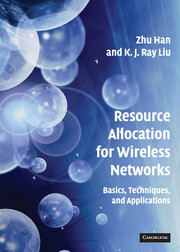6 - Optimization Formulation and Analysis
from Part II - Optimization Techniques for Resource Allocation
Published online by Cambridge University Press: 05 August 2012
Summary
Introduction
In wireless networks, the available radio resources such as bandwidth are very limited. On the other hand, the demands for wireless services are exponentially increasing. Not only is the number of users booming, but also more bandwidth is required for the new services such as video telephony, TV on demand, wireless Internet, and wireless gaming. How to accommodate all these requirements has become an emergent research issue in wireless networking. Resource allocation and its optimization are general methods to improve the network performances.
The design of wireless networking is usually conducted in two different styles. For physical-layer researchers, the bandwidth is very limited and optimization is critical to approach the optimality, such as the Shannon capacity. On the other hand, for higher-layer researchers, it is mostly impossible to have any analytical solution. Therefore the design criteria is often heuristic. There are trade-offs between these two types of approaches. One of our major goals is to present these trade-offs so that better implementations can be put into practice.
In this chapter, we discuss how to formulate the wireless networking problem as a resource-allocation optimization issue. Specifically, we study what the resources are, what the parameters are, what the practical constraints are, and what the optimized performances across the different layers are. In addition, we address how to perform resource allocation in multiuser scenarios. The trade-offs between the different optimization goals and different users' interests are also investigated. The goal is to provide readers with a new perspective from the optimization point of view for wireless networking and resource-allocation problems.
- Type
- Chapter
- Information
- Resource Allocation for Wireless NetworksBasics, Techniques, and Applications, pp. 137 - 153Publisher: Cambridge University PressPrint publication year: 2008



